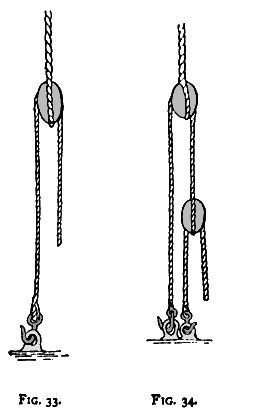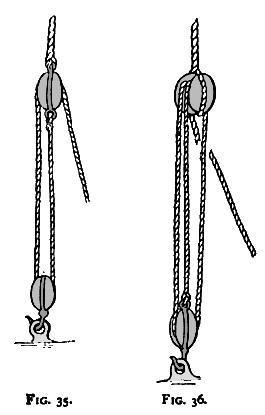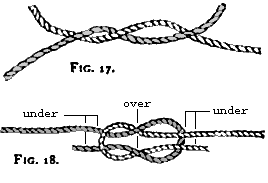 There
are various tackles and purchases employed on a yacht's rigging, by
which mechanical advantage is gained; but of course what is gained in
power is lost in time. Thus a system of pulleys that enables a pull of
five pounds to raise fifty pounds, involves the hauling of ten times
the length of rope through the blocks than would be the case were no
purchase used. On a small yacht, therefore, where it is important that
sails should be hoisted and lowered quickly, no purchase should be more
powerful than is absolutely necessary, that is, it should just enable
one man to do the particular work for which it is employed. To
overblock a little yacht entails a delay in every operation, and an
increased risk of ropes jamming.
There
are various tackles and purchases employed on a yacht's rigging, by
which mechanical advantage is gained; but of course what is gained in
power is lost in time. Thus a system of pulleys that enables a pull of
five pounds to raise fifty pounds, involves the hauling of ten times
the length of rope through the blocks than would be the case were no
purchase used. On a small yacht, therefore, where it is important that
sails should be hoisted and lowered quickly, no purchase should be more
powerful than is absolutely necessary, that is, it should just enable
one man to do the particular work for which it is employed. To
overblock a little yacht entails a delay in every operation, and an
increased risk of ropes jamming.
The following are the tackles and purchases in common use on
small yachts :--
The SINGLE-WHIP PURCHASE (Fig. 33) has a single block. This
is the purchase employed for the fore and jib halyards of a small
cutter; the block, as is explained in the chapter on a cutter's
rigging, being hooked on to the cringle of the sail. A pull of one
pound on the hauling part puts a strain of two pounds on the block.
The WHIP-UPON-WHIP PURCHASE (Fig. 34) is employed for the
preventer backstays on small cutters. A pull of one pound on the
hauling part exerts a force of four pounds at the upper block.
 The
GUN-TACKLE PURCHASE (Fig. 35) has two single blocks with the standing
part of the rope made fast to the upper block. A pull of one pound on
the hauling part exerts a force of three pounds at the upper block.
This purchase can be employed for bowsprit shrouds, main tack tricing
line, etc.
The
GUN-TACKLE PURCHASE (Fig. 35) has two single blocks with the standing
part of the rope made fast to the upper block. A pull of one pound on
the hauling part exerts a force of three pounds at the upper block.
This purchase can be employed for bowsprit shrouds, main tack tricing
line, etc.
A LUFF-TACKLE PURCHASE (Fig. 36) has the same power as the
whip-upon-whip purchase. It has one single and one double block, the
standing part of the tackle being fastened to the single block. It is
used for a variety of purposes, among others for the main sheet on a
small cutter.
A WATCH TACKLE is a luff tackle with a tail rope some feet
in length-on the double block, and a hook on the single block. A watch
tackle should always be kept in some convenient place on a yacht's
deck, for it is employed on all sorts of odd jobs which more beef' is
wanted. It is indeed almost worth an extra hand on board, so sailors
dub it the "Handy Billy." Among other things it is useful for
setting up the rigging. It is employed as follows: the single block is
hooked on to a ring-bolt on deck, or to a strop or bight of a rope
secured to the bits or other strong piece of timber; while the tail of
the double block is fastened by a rolling hitch (see Fig. 25) to the
shroud or rope which has to be hauled taut.
Power can be multiplied when necessary, by clapping one
purchase on another. A Luff-upon-Luff Tackle, for example, is
formed with two watch tackles by bending the tail of the double block
of the second tackle on the fall of the first tackle. A pull of one
pound on the hauling part will then exert a force of sixteen pounds at
the further end of the tackle.
If some accident happen to one part of a tackle or purchase
-- if a strand be chafed through, for example -- and it becomes
necessary to repair the damage, while at the same time it is
undesirable to slack up the tackle, or to take it from the work it is
doing (e.g. in the case of a yacht's halyards or sheets during a close
race), the tackle can be racked while the repair is being carried on.
Thus, if the hauling part of the throat halyards be cut, the other
three or more parts of the halyards are racked by passing a piece of
thin line round and between them several times tightly, and then tying
the two ends of the line together with a reef knot. This grips the
parts, prevents the halyard from running through the blocks, and
enables them to hold on and withstand the strain put upon them, while
the injured part is cast loose and repaired at leisure.
![]() ...to
Plywood Boats or to The
Cheap Page or to The
Odd Sails
...to
Plywood Boats or to The
Cheap Page or to The
Odd Sails
